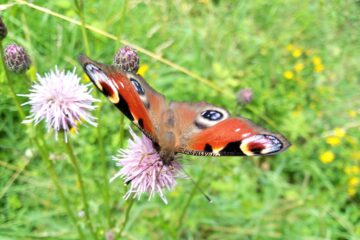
Even if you’ve been not able to get out and about recently, you may have seen coverage in the Stroud News & Journal about the shocking extent of the felling being conducted across our commons, where diseased trees are being cleared to prevent a threat to the highway and other hazards. Areas such as Besbury and Bownham commons, Pinfarthings and the “W” have been particularly badly affected, not just by the felling but by the impact of the heavy machinery needed to bring it about.
The disease in question is ash dieback, which is caused by a fungus called hymenoscyphus fraxineus and which affects the structural integrity of the tree, causing loss of limbs and in most cases death. Speaking to Nailsworth CAN, arboriculturist Rachael Emous-Austin recently explained that “Diseased trees next to roads pose a risk to people and property, therefore they need to be removed. If you own trees that may cause a hazard to either people or property, it is your legal responsibility to have those trees assessed and to look after them. For a practical guide to ash dieback symptoms follow this link to the Arboricultural Association“.
Across Gloucestershire, GCC Highways anticipate having to fell between 27,000 and 32,000 ash trees over the next few years as a result of ash dieback, 3,300 of them by the end of 2021. Many of these will be sited on private land, and one of the most significant landowners in this area is the National Trust. I spoke to the local National Trust warden, Richard Evans, who acknowledged that this necessary work has had an adverse effect on some areas of the commons, in part due to the soft ground after months of rain, but that safety concerns (and to a lesser extent, the timing of road closures) meant that the work had to proceed as planned. The equipment may look heavy-handed, but the strict safety guidelines which govern how this work must be conducted have meant using much larger machinery than they’d like to in such precious wildlife habitats.
Forest cover is a key part of our carbon reduction strategy, so to witness such widespread destruction in our woodlands is particularly upsetting, but we must focus on solutions. You may notice that the tree stumps and wood chippings are often left in place after felling – this is to aid natural regeneration and, in the case of the stumps, biodiversity, as these can harbour rare beetle species. Unaffected trees are left in place wherever possible, to promote any natural resistance to the fungus. The National Trust have a programme of rectification planned, including restoring churned up ground and reseeding of grassland where it has been damaged. The county council announced this month that they plan to plant two trees for every tree felled, with the help of local partners.
If you’re considering replacement planting after dieback on your own land, Rachael Emous-Austin had the following tips: “promote natural regeneration wherever possible, particularly in woodlands. When replacing trees use the 3/2/1 formula: at least 3 new trees for loss of a large tree, 2 for a medium tree and 1 tree for a small tree. No one species alone can substitute ash. However, Aspen, Alder, Field Maple, Sycamore, Birch, Rowan and Disease-resistant Elm, along with Native Oaks, are good contenders.”
To stand a chance of reaching carbon zero by 2030 in our parish, we need to plant many more more trees, and we are launching a project to do just that – do get in touch if you’d like to be involved in any way.
Read more on ash dieback and community tree planting
GCC Highways FAQ on ash dieback
National Trust: Restoring woodlands affected by ash dieback
Woodland Trust guide to planting trees


